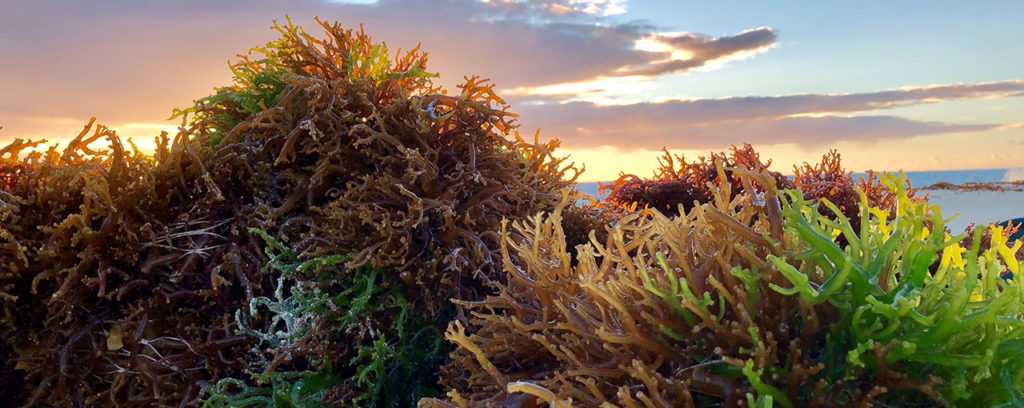Pacific Sea Moss Species?
We use a variety of seaweeds (macroalgae) that grow in the subtropical waters. We currently only use Kappaphycus alvarezii (often commonly called cottinii and previously called E. cottonii).
There are from 30,000 to 1 million of algae, but for macro-algae, there are at least some 13,000 species. Humans only use about 13 species commercially although there are dozens (>97) species in the Philippines and there are species not yet identified. Genetic profiling of seaweeds is only just beginning.
Taxonomists and seaweed researchers typically describe 3 types and include species from the Rhodophyta (red), Phaeophyta (brown) and Chlorophyta (green) families of macroalgae. This is very confusing, except for taxonomists. E.g. The red seaweeds of Eucheumia and Kappaphycus were only separated into 2 separate genera in 1988. They exist in a range of morphologies and colours depending on where it grows! Common names exist but these sometimes refer to different species. For example, Elk sea moss is a USA name, guso, kanot-kanot and Tambalang are all common names for K. alvarezii but in some locations the species is actually not that one.
Varieties of Pacific Sea Moss?
Red seaweeds
- Kappaphycus alvarezii – called cottonii in the Philippines / Indonesia / Malaysia and grown for its kappa-carrageenan content. Prior to 1985 the taxonomic name was Eucheuma cottonii. This is the primary species used in Pacific SeaMoss and also on the “BELFRIT” list of accepted food seaweeds. The primary carrageenan produced is kappa-carrageenan sulfated polysaccharides.
- Eucheuma spinosum. The new proper species name is E. denticulatum but most literature still refers to it as E. spinosum or “spinosum”. It has a wide range of phentoypes – i.e. some cultivars look like different species, but are genetically probably the same. Called guso in Philippines and generally green in colour but can be brown, red or green in colour. The species is on the approved list in Europe. The list is the “BELFRIT” list of accepted food seaweeds. (Shortened from Belgium, France and Italy). This species produces iota-carrageenan sulfated polysaccharides.
- Chondrus crispus is a red seaweed, also called Irish moss and is a common edible red seaweed that can be found on rocky shores in the Northern Atlantic. The cell wall contains carrageenan and C. crispus is the original source of this commercially used thickener.
- Porphyra if probably the most domesticated seaweed. Known as Nori in Japan, “laver” in the United Kingdom, the United States, and Canada, “purple laver” in Britain and Ireland, “karengo” in New Zealand, “gim” or “kim” in Korea, and “zicai” in China, is primarily used as food in the Japanese delicacy “sushi,” which consists of roasted blades, fish, rice, and other ingredients. There are 60 to 70 species worldwide.
- Halymenia (some 70 species)
- Gracilaria is used as a food in Japanese, Hawaiian, and Filipino cuisine. In Japanese cuisine, it is called ogonori or ogo. In the Philippines, it is called gulaman and used to make gelatin. In Jamaica, it is known as Irish moss. There are many species
- Dulse (Dulsepalmaria palmata) is a cool water red sea moss and gained media attention as “seaweed bacon”.
- Gigartina skottsbergii, Irdae or Mazzaella laminarioides species are wild harvested for carrageenan production in Chile (from Concepcion to Chiloe Island).
- Sarconema filiforme is a red seaweed found in Queensland, Australia, with iota-carrageenan and was used in an obesity experiment.
Green seaweeds
- Caulerpa lentillifera – sometimes called sea grapes or “Umibudo” in Japan and grown throughout the Pacific.
- Aonori or green laver (Monostroma spp. and Enteromorpha spp.)
- Ulva sp or sea lettuce. Sea lettuce is eaten by a number of different sea animals, including manatees and the sea slugs known as sea hares. Many species of sea lettuce are a food source for humans in Scandinavia, Great Britain, Ireland, China, and Japan (where this food is known as aosa). Sea lettuce as a food for humans is eaten raw in salads and cooked in soups. It is high in protein, soluble dietary fiber, and a variety of vitamins and minerals, especially iron. The issue with sea lettuce is contamination with toxic heavy metals.
Brown seaweeds
- Sargassum has a number of species, and generally free-floating. Sargassum is not a prime edible but a plentiful one. It can be eaten by itself or added to fish and meat dishes. If not strong it can be added to salads after washing, or it can be cooked in water like a vegetable.
- Kombu or haidai. Laminaria is a genus of 31 species of brown algae commonly called “kelp”. Some species are also referred to as tangle. This economically important genus is characterized by long, leathery laminae and relatively large size. Names include bull kelp, giant kelp, and Kombu or haidai in Japan. It may be a range of species including L. longissima, L. japonica, L. angustata, L. coriacea and L. ochotensis.
We make no medical claims. But we all understand seaweed is healthy. What you may not know is that peer-reviewed scientific papers have shown in countless studies on humans, animals and in test tubes that seaweed is healthy. BioSea Health provides seaweed as a simple way to consume food. Simply good healthy food.

